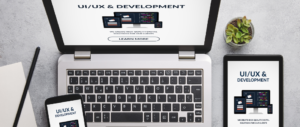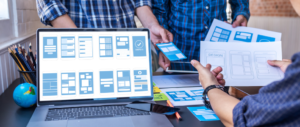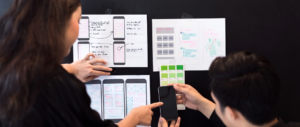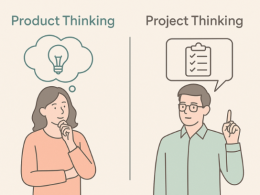How many times have you landed on a website or used a mobile app and immediately thought, “Wow, this looks and feels amazing!”? Chances are, it’s happened more times than you can count. That’s the power of outstanding User Experience (UX) and User Interface (UI) design.
In today’s digital age, where user attention spans are shorter than ever, creating exceptional digital experiences is not just a nice-to-have; it’s a necessity. User expectations are constantly evolving, and as product designers and developers, it’s our responsibility to stay ahead of the curve.
But how do you keep up with the ever-changing landscape of UX/UI design?
Which trends are shaping the future of product design in 2023 and beyond?
These are the exciting questions we’ll explore in this comprehensive blog. So, fasten your seatbelts, because we’re about to embark on a journey through the top UX/UI trends that are redefining the way we design and interact with digital products.
The Fusion of Art and Science
As we delve into the world of UX/UI design trends, it’s important to understand that this field is a beautiful fusion of art and science. On one hand, it’s about creating visually stunning and aesthetically pleasing interfaces. On the other hand, it’s deeply rooted in user psychology, behavior, and data-driven decision-making. Striking the right balance between these two aspects is where the magic happens.
So, what’s in store for the future of product design?
Let’s start by addressng some intriguing questions:
1. AI and Machine Learning Reshaping UI.
How is artificial intelligence transforming user interfaces, and what does it mean for product design?

Artificial Intelligence (AI) and Machine Learning (ML) are at the forefront of reshaping user interfaces, introducing revolutionary changes in how users interact with digital products.
Here’s a closer look at the transformative impact of AI and ML on UI design:
A. Personalization
- Understanding User Behavior: AI algorithms have the remarkable ability to analyze extensive user data, such as browsing history, preferences, and past interactions. This data-driven approach provides deep insights into individual user behavior.
- Highly Personalized Experiences: AI leverages this data to create highly personalized experiences for users. It tailors content recommendations, product suggestions, and interface elements to align with each user’s unique preferences and needs.
- Netflix’s Recommendation System: A prominent example of AI-driven personalization is Netflix’s recommendation system. By examining your viewing history, the system suggests movies and TV shows that align with your tastes, enhancing your overall viewing experience. This level of personalization keeps users engaged and encourages them to explore more content.
B. Predictive Interactions
- Enhancing User Intuitiveness: AI-powered predictive interactions make user interfaces more intuitive. By analyzing user behavior patterns, AI can anticipate and predict the next user action, reducing friction in the user experience.
- Predictive Text on Smartphones: A familiar example of predictive interactions is the predictive text feature on smartphones. As users type, the system suggests words or phrases based on context and previous typing patterns. This not only streamlines communication but also reduces typing effort, enhancing user efficiency.
C. Chatbots and Virtual Assistants
- Instant Support and Guidance: AI-driven chatbots and virtual assistants are becoming increasingly sophisticated, offering users instant support and guidance within digital products and services.
- Conversational UIs: These AI-powered virtual assistants facilitate conversational user interfaces, enabling users to interact with software or systems using natural language. This approach makes interactions feel more human-like and less technical.
- Enhanced User Experiences: Whether it’s answering questions, helping users navigate complex processes, or providing recommendations, chatbots and virtual assistants contribute to more seamless and enjoyable user experiences.
2. Pushing the Boundaries of Minimalism
How can designers maintain simplicity while pushing the boundaries of minimalism?

Minimalism, characterized by simplicity, clarity, and a focus on essential elements, continues to be a dominant design philosophy. However, designers are constantly pushing the boundaries of minimalism to create sleek, efficient, and aesthetically pleasing interfaces. Here’s how they achieve this delicate balance:
A. Microinteractions
- Enhancing User Engagement: Microinteractions are subtle animations or feedback that respond to user actions. These small, purposeful animations provide visual cues and feedback without overwhelming users.
- Adding Depth and Character: In minimalist designs, microinteractions add depth and character, making the interface more engaging. For example, when a user hovers over a button, it might subtly change color or animate, indicating its interactability.
- Improving User Understanding: Microinteractions can also help users understand the system’s response to their actions. They provide immediate and intuitive feedback, reducing uncertainty and enhancing the user experience.
B. Whitespace and Typography
- Creating Spaciousness: In minimalist design, the strategic use of whitespace, also known as negative space, creates a sense of spaciousness. Whitespace helps guide the user’s focus to key elements and reduce visual clutter.
- Typography Choices: Typography plays a crucial role in minimalist design. Designers carefully select fonts that align with the brand’s personality and the content’s tone. Typography has become a powerful tool for conveying information and creating visual hierarchy.
- Contrast and Legibility: Minimalist design often relies on high-contrast typography for readability. Bold, clean fonts are preferred to ensure that text is easily legible against the background.
C. Monochrome and Duotone
- Maintaining Minimalism: Designers experiment with monochrome (single-color) or duotone (two-color) color schemes to maintain a minimalist look while introducing visual interest.
- Highlighting Key Elements: In a monochrome or duotone palette, designers can use color strategically to highlight specific elements or calls to action. This selective use of color draws the user’s attention to critical areas.
- Creating Memorability: Monochrome or duotone designs, when executed effectively, can be striking and memorable. They convey a sense of simplicity and sophistication, which aligns with minimalist principles.
3. The Voice-First Revolution
How is the rise of voice user interfaces reshaping digital product design?

The Voice-First Revolution represents a significant shift in how users interact with technology. Voice User Interfaces (VUIs) are becoming increasingly prevalent, offering users a more natural and hands-free way to engage with digital products.
Here’s how this trend is reshaping digital product design:
A. Voice Assistants
- Natural Interaction: Voice assistants like Siri, Alexa, and Google Assistant provide users with a natural and intuitive way to interact with technology. Users can issue voice commands, ask questions, and receive responses in real time.
- Device Control: VUIs enable users to control a wide range of devices, from smart speakers and thermostats to home automation systems. This hands-free control enhances convenience and accessibility.
- Voice-Activated Apps: Designers are integrating voice-activated features into mobile apps, enabling users to perform tasks and access information by simply speaking to their devices. This functionality is particularly valuable for users with mobility issues.
B. Voice Search
- Changing Search Behavior: As users increasingly rely on voice commands to find information, designers and businesses must optimize their content for voice search. Voice search queries are typically more conversational and long-tail, so content should be structured to align with these patterns.
- Local Optimization: Voice search often includes location-based queries (e.g., “Where is the nearest coffee shop?”). Local businesses must ensure that their online presence is optimized for local searches to appear in relevant voice search results.
C. Conversational Design
- Seamless Interactions: Designing for VUIs requires a new approach known as conversational design. This involves creating interfaces that facilitate seamless and user-friendly conversations between users and voice assistants.
- Human-Like Interactions: The goal of conversational design is to mimic genuine human interactions. Designers must consider factors like natural language processing, context awareness, and response tone to make interactions feel more human-like.
- Multi-Modal Design: Conversational design extends beyond voice alone. Designers also consider how visual elements (e.g., on a screen) can complement voice interactions, providing users with a multi-modal experience.
4. The 3D and Immersive Experience
How are 3D elements and immersive experiences enhancing digital product design?

The integration of 3D elements and immersive experiences represents a transformative shift in digital product design. It redefines how users engage with digital interfaces and offers a range of benefits.
Here’s a closer look at how 3D and immersive technologies are enhancing digital product design:
A. Augmented Reality (AR)
- Overlaying Digital on Reality: AR technology overlays digital information, such as graphics, animations, or data, onto the real world. Users can view this augmented content through devices like smartphones or AR glasses.
- Applications Across Industries: AR finds applications in various industries, from gaming and e-commerce to education and healthcare. For instance, in e-commerce, users can use AR to visualize how furniture would look in their homes before making a purchase.
- Enhanced Engagement: AR enhances user engagement by providing interactive and contextual information. It bridges the gap between the digital and physical worlds, creating a more immersive experience.
B. Virtual Reality (VR)
- Immersing Users in Digital Environments: VR technology immerses users in entirely digital environments. Users wear VR headsets that simulate a three-dimensional world, often with a 360-degree view.
- Revolutionizing Industries: VR has revolutionized industries such as real estate, where users can take virtual property tours, and training simulations, where professionals can practice skills in a risk-free environment.
- Immersive Learning: In education, VR offers immersive learning experiences. For example, students can explore historical landmarks in VR or dissect virtual organisms in biology lessons.
C. 3D Elements in UI
- Enhancing User Engagement: Designers are incorporating 3D elements like buttons, icons, and interactive components into user interfaces. These elements add depth, realism, and interactivity to the user experience.
- Creating Realistic Interactions: 3D elements can respond to user interactions in a more lifelike manner. For instance, a 3D button might depress when clicked, providing visual feedback that enhances user understanding.
- Improving Visualization: In industries like architecture and product design, 3D elements in UIs help users visualize complex structures or designs more effectively. Users can rotate, zoom, and interact with 3D models.
5. The Ethics of UX/UI Design
What ethical considerations should designers prioritize in their work?

As technology’s influence continues to grow, the ethical dimensions of UX/UI design have become increasingly important.
Here are key ethical considerations that designers must prioritize:
A. Data Privacy
- Transparent Data Practices: Ethical UX/UI design demands transparency in how user data is collected, used, and stored. Designers must ensure that users are informed about data practices and have the option to provide informed consent.
- Secure Storage: Protecting user data through secure storage mechanisms is paramount. Designers should collaborate with security experts to safeguard sensitive user information from data breaches or unauthorized access.
- User Consent: Obtaining clear and explicit user consent for data collection and usage is an ethical imperative. Users should have the choice to opt in or opt out of data sharing, and their preferences should be respected.
B. Inclusivity
- Designing for All Users: Ethical UX/UI design means designing for inclusivity. Designers should consider the diverse needs of all users, including those with disabilities, and ensure that digital products are accessible to everyone.
- Accessibility Standards: Compliance with accessibility standards, such as the Web Content Accessibility Guidelines (WCAG), is essential. This involves making digital content perceivable, operable, and understandable for users with various disabilities, including visual, auditory, and motor impairments.
- User Testing with Diverse Audiences: Ethical designers conduct user testing with diverse groups to identify and address potential accessibility issues. User feedback and testing with individuals who have disabilities are crucial for creating truly inclusive interfaces.
C. Digital Wellbeing
- Mental and Emotional Impact: Ethical UX/UI designers consider the potential mental and emotional impact of digital products on users. They aim to create experiences that enhance users’ well-being rather than causing harm or addiction.
- Features for Digital Wellbeing: Designers can incorporate features that promote digital well-being, such as screen time monitoring, notification management, and tools that encourage breaks from technology.
- Balanced Design: Ethical UI design involves striking a balance between engaging users and respecting their need for healthy boundaries. Designers should avoid designs that exploit addictive behavior or encourage excessive screen time.
6. Future-Proofing Your UX/UI Design Skills
What skills and qualities will designers need to thrive in a constantly evolving field?

In a field as dynamic and rapidly changing as UX/UI design, staying relevant and effective requires a specific set of skills and qualities.
Here’s a closer look at what designers need to thrive:
A. Adaptability
- Learning Agility: UX/UI designers must be quick learners who can adapt swiftly to new tools, technologies, and design paradigms. The digital landscape evolves rapidly, and designers who can embrace change are well-equipped to stay ahead.
- Mastery of Tools: Being proficient in a variety of design tools and software is essential. Whether it’s the latest prototyping tool, design software, or coding language, designers should continuously update their skill sets.
B. Empathy
- Understanding User Needs: Empathy is at the heart of effective design. Designers need the ability to understand and empathize with users’ needs, frustrations, and desires. This understanding allows for the creation of user-centric interfaces.
- User Research: Conducting user research and user testing is a critical part of design. Designers must listen to user feedback, observe behavior, and use these insights to inform their design decisions.
C. Ethical Awareness
- Recognizing Ethical Implications: Design choices can have ethical implications. Designers must be aware of the potential consequences of their decisions, such as the impact on user privacy, inclusivity, and digital well-being.
- Responsible Design: Ethical awareness goes hand in hand with responsible design. Designers should prioritize creating products and interfaces that are respectful, accessible, and beneficial to users and society at large.
D. Communication Skills
- Effective Communication: UX/UI designers often collaborate with cross-functional teams, including developers, product managers, and marketers. Strong communication skills are vital for conveying design concepts and rationale effectively.
- Presentation Skills: Designers should be able to present their ideas and designs convincingly, both internally to team members and stakeholders and externally to clients or users.
E. Creative Problem-Solving
- Problem Identification: Designers should excel at identifying and defining design problems. This involves understanding the user’s context and needs and translating them into design challenges.
- Innovative Solutions: Creative problem-solving skills enable designers to generate innovative and effective solutions to design challenges.
F. Continuous Learning
- Staying Informed: Designers must be committed to continuous learning. They should stay informed about industry trends, emerging technologies, and best practices through books, courses, workshops, and conferences.
- Building a Portfolio: Designers should continually update and expand their portfolios to showcase their evolving skills and expertise.
The landscape of product design is undergoing a profound transformation, guided by the ever-evolving world of user experience (UX) and user interface (UI) trends. In this exploration of the top UX/UI trends shaping the future of product design, we’ve witnessed a dynamic shift driven by technological advancements, user expectations, and ethical considerations.
From AI-driven personalization to the rise of voice interfaces, the integration of 3D elements, and the imperative of ethical design, these trends collectively redefine how we interact with digital products. Moreover, the emphasis on adaptability, empathy, and ethical awareness underscores the qualities that designers must cultivate to thrive in this rapidly changing field.
As we embrace these trends, we embark on a journey of innovation and user-centricity, where design isn’t just about aesthetics but also about enhancing lives, respecting privacy, and ensuring inclusivity. These trends promise to shape a future where digital products and experiences are more engaging, accessible, and ethically responsible than ever before, ushering in an era of design excellence and meaningful impact.
 Pin
PinReady to take your product management skills to the next level? Join Accredian’s Product Management Course today and unlock a world of opportunities.
Don’t miss out on this chance to supercharge your career! Enroll now!






